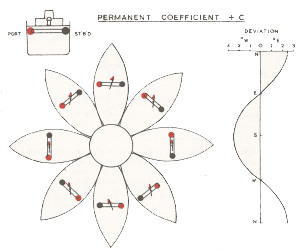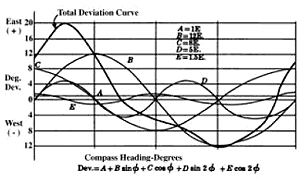Compass Deviation Analysis Explained
Compass deviation data usually have a very characteristic pattern, which can be analyzed mathematically into various components, or Coefficients. Compass analyis is useful because each of the Coefficients (or more precisely, 'Apparent Coefficients') is associated with a certain type of problem, and each coefficient can be addressed individually. Knowing the value of the Coefficients can simplify the process of compass adjustment and can help explain the source or cause of compass deviations that cannot be corrected.
How to determine the Apparent Coefficients is discussed in some detail in The American Practical Navigator HO 9, Chapter 6 (Bowditch). Beginning at page 14.
Here is a quick course:
Fig 1. shows a ship with a compass deviation of 2.5 degrees caused by athwartship permanent magnetism, which produces Apparent Coefficient C. Note the distinctive sine wave pattern of the graph. Fig 1.
Typically, compass deviation is analyzed into 5 Coefficients: A, B, C, D & E. And the total deviation is the sum of all the coefficients (see Figure 2).
Separating the Coefficients using Analysis will suggest a source of each component, as well as a possible way to correct it.
Coefficient A: is a constant error which is the same on all headings
- Typically occurs when the compass is not installed with the lubber line parallel with the fore & aft axis of the boat, or by a defective compass card
- Most often corrected by rotating the compass or by changing the compass card
Coefficient B: varies as a function of the sine of the compass heading, and
- is usually associated with fore-and-aft permanent magnetism.
- is corrected using fore-and-aft magnets.
Coefficient C: varies as a function of the cosine of the compass heading, and
- is usually associated with athwartship permanent magnetism.
- is corrected using athwartship magnets.
Coefficient D: varies as a function of the sine of twice the compass heading, and
- is associated with induced magnetism caused by symmetrical soft iron (either in the ship itself or from proximity to shielding around electronics)
- is often corrected using quadrantal spheres.
Coefficient E: varies as a function of the cosine of twice the compass heading, and
- is associated with induced magnetism caused by asymmetrical soft iron (think about a compass off center as it would be installed on an aircraft carrier)
- is corrected by slewing the quadrantal spheres.
Try experimenting with the Compass Deviation Analysis Calculator.

 Figure 1
Figure 1
 Figure 2
Figure 2